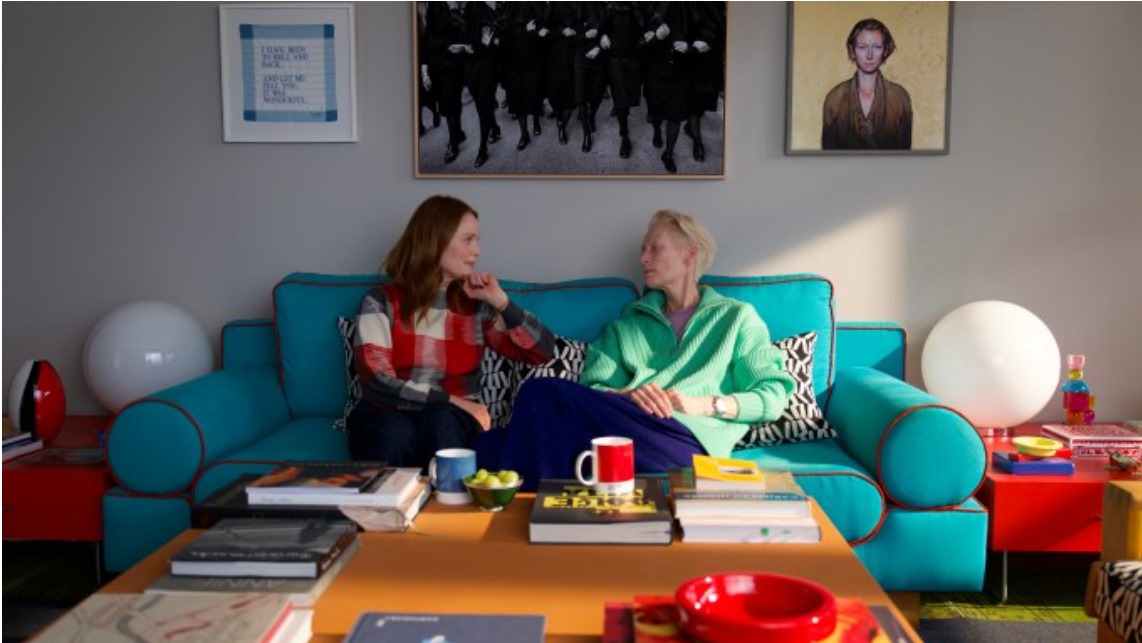
Pedro Almodóvar’s The Room Next Door (2024), screened in the “Cinema International” section of the Kolkata International Film Festival, marks the director’s highly anticipated English-language debut following his 2021 Spanish drama, Parallel Mothers. The 110-minute film, replete with Almodóvar’s signature visual grammar, is an adaptation of Sigrid Nunez’s novel What Are You Going Through. Julianne Moore, portraying Ingrid Parker, a novelist, and Tilda Swinton as Martha, a terminally ill war correspondent, attempt to deliver an existential poetics in this tale of two old friends reconnecting under the spectre of death.
This Golden Lion winner at the Venice revolves around the uneasy companionship of Ingrid and Martha as they navigate through guilt, resilience, and unfulfillment. At a book signing, Ingrid (Moore)learns from an acquaintance that her estranged friend Martha (Swinton) is gravely ill. Their reunion erases the years apart. Cinematographer Eduard Grau captures their expressive faces. Bina Daigeler’s vibrant costumes and Inbal Weinberg’s dazzling sets create a lively atmosphere. The hospital room, with a vase of snapdragons and a stunning Manhattan skyline view, feels oddly celebratory despite the looming presence of death.
Their journey to Woodstock is marked by moments of dark humour and tender vulnerability. This is not merely a story of two women confronting death but a meditation on the ways we inhabit our relationships with others and with the world. The film resonates less as a narrative and more as an experience. In the coupling of Ingrid and Martha, the director explores a dialectics of the psychosomatic and the artifactual. At its heart, The Room Next Door is a political film. Its exploration of euthanasia, environmental degradation, and social alienation situates it within a broader discourse on the nature of contemporary existence.
The Room Next Door is a study in unfulfillment. The characters live within “an ecology of separation”, to borrow Frédéric Neyrat’s term—where interconnection requires distance, intimacy necessitates alienation. The film’s melancholia is not a mourning of death but an acknowledgment of life’s inexorable precarity, a submission to its inexhaustible transformations. In this entropic world, where mortality is technologized and individuality atomized, Almodóvar crafts a narrative of relationality. It holds the tension of life’s duality: its unity and its separation, its materiality and its dream.
Almodóvar’s visual storytelling is a meditation on the aesthetics of disjunction. The mise-en-scène, saturated in a palette of vibrant hues, mediates the psychosomatic and artifactual dimensions of the characters’ journeys. It feels like a reverie where materiality is imbued with dream-like, almost transcendental significance. The snow-covered landscapes of Woodstock, where the climax unfolds, works as a counter-lining of their shared intimacy, concealing and revealing the inevitability of Martha’s chosen departure. The film’s intertextual references from James Joyce’s The Dead to Roberto Rossellini’s Journey to Italy reinforce the film’s material-aesthetic construction, its themes of temporality and relationality.
The film’s visual vocabulary signifies a nature technologized and mediated by human interventions. Almodóvar’s America, as depicted in the film, is a landscape scarred by neoliberalism, climate change, and social alienation. It is also a space of resistance and resilience, where personal narratives intersect with larger socio-political currents.
Illegal euthanasia is framed not as an act of despair but as a radical assertion of agency. Ingrid’s role as a witness and accomplice to this act becomes a site of ethical and emotional turbulence. Despite Julianne Moore and Tilda Swinton’s earnest efforts to convey the weight of grief, desire, and the search for closure in the most tenuous of moments, their performances often come across as overtly self-conscious and occasionally wooden. John Turturro’s portrayal of Damian Cunningham who forces a global warming subplot into the film, feels contrived and didactic. The narrative is at times strangely and overly stylized, lacking the much-required sense of urgency and emotional grip. Although never boring or unpleasant, it often feels performative and uneven. The audience counts down minutes, waiting for a twist that arrives in the final act but never touches the melancholic finality. It feels unearned, aloof, and oddly mysterious. Let’s just say that the casting choice for Martha’s daughter doesn’t work.
One of the film’s major flaws is its dialogue. It has an unnatural, translated quality. While the words technically convey emotional truths and move the plot forward, they just don’t feel and sound correct. This linguistic dissonance makes it difficult to engage fully with the emotional drama unfolding on the screen. A story about companionship and mortality should speak for itself, but here it is wrapped in strange language.
Martha’s journey toward planned euthanasia feels like more than an escape—raising questions about privilege: is this how the wealthy would choose to die? The visual architecture of the film—an agglomerate of colour, fashion, and set design—makes it lush and stunning. Funky sweaters, bold lipsticks, and bright blocks of colour contrasts starkly with its sombre themes. This prompts the question: is Almodóvar prioritizing style over substance, or is this his confrontational approach to the biopolitics of death?
Caught between visual opulence and tragic sobriety, the film’s aesthetic choices remain open to interpretation. I hope these choices are not merely decorative but evocative of life’s inherent dichotomies. In that case, Martha’s funky wardrobe stands out as a kind of exosomatic organ, embodying her fractured relationship with time and memory in the fractured ecology of being. At its best, The Room Next Door attempts to capture a counter-lining of existence—a living out of the disjunction between life’s continuity and its impending cessation, though it struggles to achieve its full emotional potential.